Photos by Mimi Bigelow Steadman
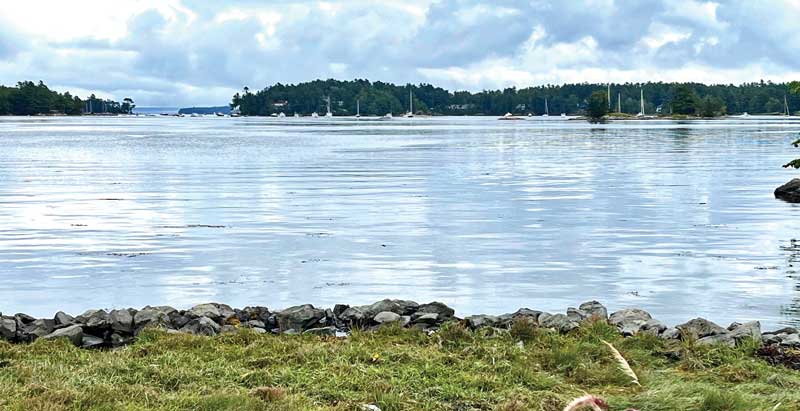 Blue Hill’s broad inner harbor mostly drains at low tide, necessitating the placement of moorings far from the center of town.
Blue Hill’s broad inner harbor mostly drains at low tide, necessitating the placement of moorings far from the center of town.
Rain-spattered leaves brushed my arms as we threaded our way down a narrow, woodsy trail in the Native Gardens of Blue Hill. On that mid-September morning, we were alone in this hidden garden behind the Bagaduce Music Lending Library. As I ambled along, I couldn’t stop thinking about the immensely talented Jonathan Fisher.
We’d just come from his house, a half mile away. A simple yellow-clapboard structure, it exudes early 19th-century rural charm. Inside, however, it’s quickly apparent that its appeal runs far deeper.
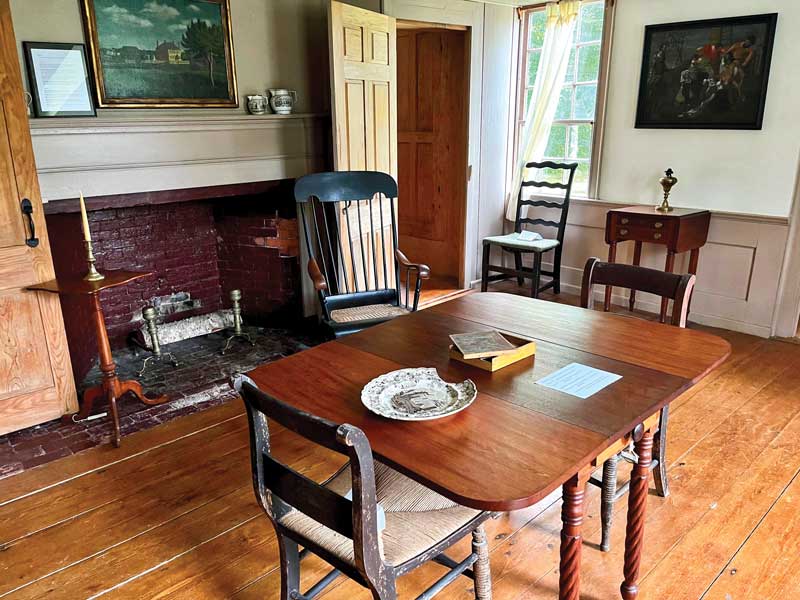 The Jonathan Fisher House is still furnished with pieces crafted by the parson in the 19th century.
The Jonathan Fisher House is still furnished with pieces crafted by the parson in the 19th century.
Fisher moved to Blue Hill in 1796, seven years after the town was incorporated and named for the 940-foot summit that rises beside it. A recent Harvard graduate, he became the first settled Congregational minister in this small community on the eastern side of the peninsula just west of Mt. Desert Island. With him he brought not just a strict faith, but also remarkable ability as an artist, writer, poet, furnituremaker, inventor, surveyor, engineer, mathematician, and philosopher. He was a linguist as well, proficient in at least six languages, including Aramaic and Penobscot.
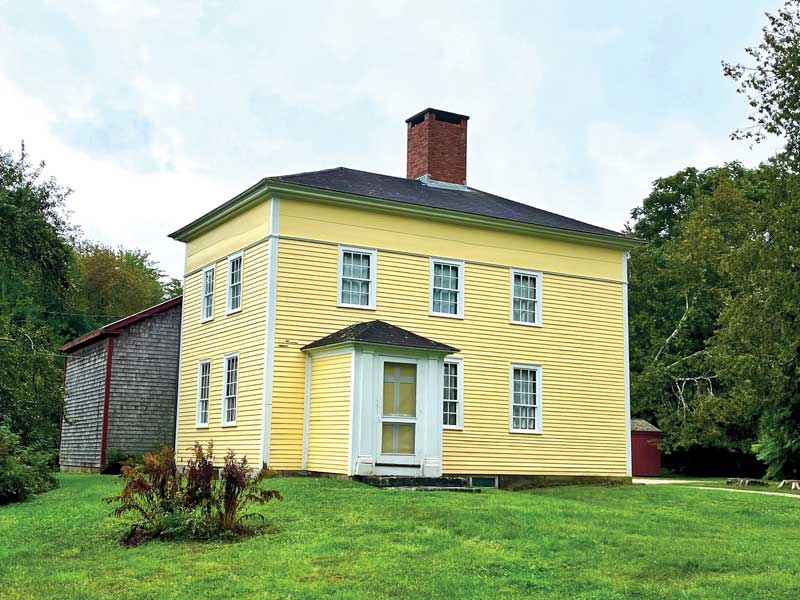 Today, Fisher’s home looks much as it would have when it was completed in 1818.
Today, Fisher’s home looks much as it would have when it was completed in 1818.
Soon after he and his wife arrived, the new parson built a rustic, three-room house. But by 1814, with their family grown to include seven children, he embarked on the four-year task of designing and helping build the modest three-story house that stands just outside the village center today.
Hannah Cyrus, board president of the Jonathan Fisher Memorial Inc., led us on a tour, pointing out examples of Fisher’s vocations and avocations: a reproduction of a panoramic painting of the entire village (the original is at the Farnsworth Art Museum), created with the help of a camera obscura he’d made; samples of printing and woodcut engravings done on a press he had constructed; homemade surveying instruments; an array of practical and sometimes inventive furniture, including a grandfather clock and a clever folding children’s desk; as well as watercolors, drawings, and a couple of self-portraits. Throughout his life, this tireless polymath also kept detailed journals penned in a shorthand he’d invented. Once deciphered, they have provided a rich account of Blue Hill in the 1800s.
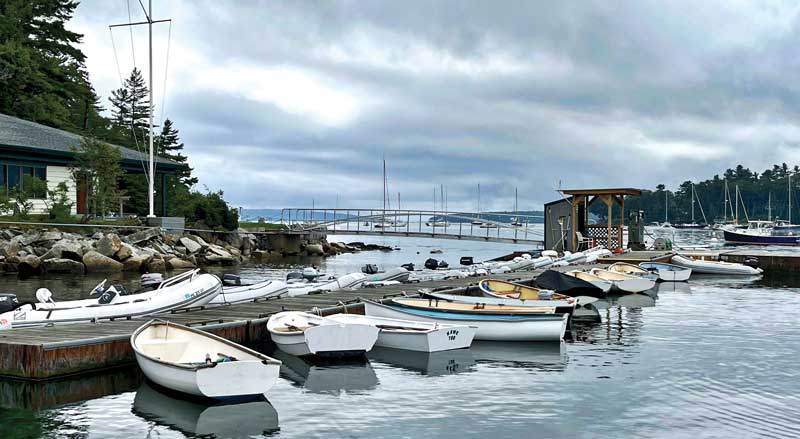 The Kollegewidgwok Yacht Club sits beside deep water at the harbor entrance.
The Kollegewidgwok Yacht Club sits beside deep water at the harbor entrance.
After spending time at the Native Gardens, we drove to the northeastern side of the village and the Kollegewidgwok Yacht Club, set on the outer edge of the harbor. The morning’s rain had retreated, but sooty clouds still smudged the sky over Mt. Desert Narrows. At the dock, a row of white dinghies practically glowed against the sullen background. I remembered our first time picking up a mooring here. I’d been puzzled to see all the boats resting so far from the village center. I soon discovered that the inner harbor pretty much dries up at low tide.
Back in town, we stopped at the Jud Hartmann Gallery, housed in a former 1830s general store. Even before entering, we were captivated by a large, graceful bronze sculpture of a loincloth-clad Iroquois warrior wielding a lacrosse stick. Inside the handsome gallery, we found more magnificently wrought bronze statues, including a collection of busts from the sculptor’s Native Peoples From Northeastern America series.
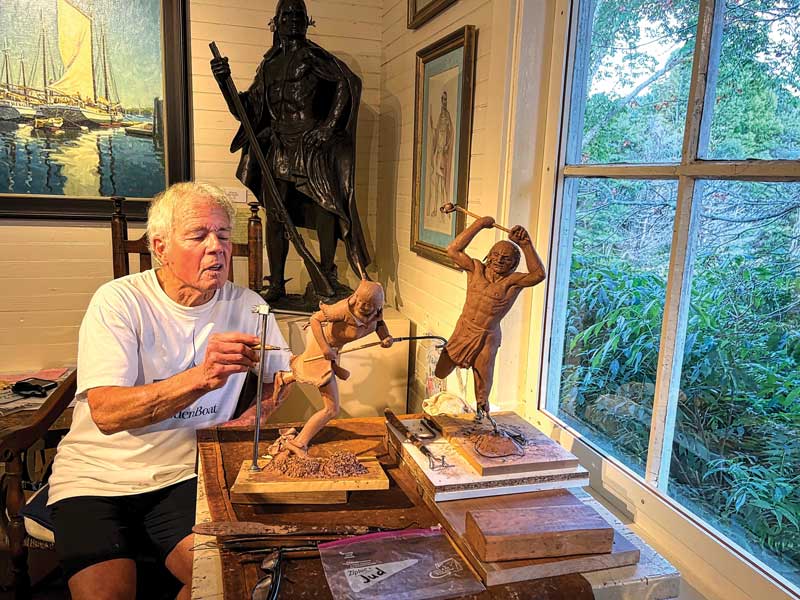 Artist and Native Peoples scholar Jud Hartmann sculpts clay figures that will later be cast in bronze.
Artist and Native Peoples scholar Jud Hartmann sculpts clay figures that will later be cast in bronze.
Hartmann greeted us warmly from the back of the gallery, where he was fashioning a small sculpture from clay. We were soon engaged in a fascinating conversation that revealed his deep knowledge of Indigenous peoples. We learned that lacrosse—the oldest sport in North America—was developed by the Iroquois and played by Eastern Woodland Tribes long before Europeans arrived. The game’s name and the first written account of it came from Father Jean de Brébeuf, a 17th-century French missionary.
Taking us around the room, the artist introduced the busts of prominent personages—including Molly Molasses, a Penobscot matriarch; and Metacomet, or King Philip, who led the last major resistance against New England colonists. It seemed Hartmann knew them intimately, and brought them all to life for us.
Hartmann’s stories and anecdotes ignited my thoughts, and they still linger with me. When exploring outdoors, be it in a nature preserve or the woods beside my house, I now walk with a deepened mindfulness of the first people to tread this ground so long ago.
✮
Contributing Editor Mimi Bigelow Steadman lives on the Damariscotta River in Edgecomb.
If you go to Blue Hill
On the Water
Harbormaster Nick Niehoff says larger vessels should anchor closer to the mouth of the harbor. To proceed into the inner harbor, follow the well-marked channel and, after clearing the last buoy (Red Nun 8), continue on a heading of 300 degrees (true) to the anchorage, with about 14 feet at low. Niehoff advises carefully consulting a chart as there are several ledges near the anchorage that might not be readily apparent. You will be about a half mile from the town docks. In the outer harbor, the Kollegewidgwok Yacht Club maintains guest moorings (nightly fee charged) and can provide fuel, ice, water, outdoor shower, trash receptacle, and pump-out service. The town of Blue Hill has two complimentary moorings in an anchorage in South Blue Hill, about five miles from the village. Niehoff notes that this anchorage is not well protected.
Do
Open spring through fall, the Jonathan Fisher Memorial Inc. provides a fascinating look into the life and accomplishments of this remarkable, multi-talented early resident of Blue Hill. Spanning nine weeks every summer, the Kneisel Hall Chamber Music Festival and School presents twice-weekly concerts featuring guest artists performing alongside members of the school faculty. Also in summer, the beloved local steel-drum band Flash in the Pans! puts on benefit concerts on Monday evenings at the town park and other area venues. For boat lovers, the Blue Hill Maritime Heritage Festival is set for Saturday, August 3, 2024. Sponsored in part by the Downeast Chapter of the Traditional Small Craft Association, the daylong event celebrates the significance of Blue Hill Bay. Held during Labor Day Weekend, the Blue Hill Fair is known for its old-time fun. In addition to midway games, mechanical rides, and food vendors, events can include women’s skillet tossing, costumed llamas, frolicking goats, performing pigs, sheepdog trials, horse-pulling competitions, traditional animal exhibits, female lumberjacks, musical performances, a Charlotte’s Web exhibit, and displays of prize-winning vegetables, fruits, and flowers.
Paddle and Hike
The Activity Shop rents kayaks, canoes, and paddleboards by the day or week, and provides info on three self-guided tours. Tucked behind the Bagaduce Music Lending Library, the Native Gardens of Blue Hill’s easy trail with boardwalks invites a pleasant meander in lush woods; many plants are identified. The Blue Hill Heritage Trust oversees four excellent properties, including Blue Hill Mountain. To climb to the peak, there’s a choice of seven trails ranging in difficulty from easy to advanced. The Trust’s Heart of Blue Hill Trail System leads through the village and includes a quarter-mile flat, wide route suitable for strollers, kids’ bikes, and wheelchairs. Another trust property, Peter’s Brook and Penny’s Preserve has a network of easy to moderate trails stretching for about 5 miles along the brook, through old granite quarries, and to a waterfall. The trust also manages Kingdom Woods Conservation, which encompasses more than 800 acres laced with three miles of trails along the shore of Fourth Pond and through freshwater wetland and upland habitats.
Eat
Blue Hill has a pleasing variety of dining choices. Tucked inside a charming shingled cottage that also offers five hotel rooms, Barncastle is known for an Alsatian-accented menu prepared by an experienced chef. Arborvine also offers a refined menu. Set in a lovely white-clapboard house, its entrées might include scallops, halibut, rack of lamb, Iberico pork, and roast duck. In an old blacksmith’s shop perched beside the rushing Mill Stream, Blaze serves pubby comfort food, some of it wood-fired. Highlights include tacos, burgers, fried haddock sandwiches, fish and chips, and prime rib. Another popular gathering spot, Marlintini’s features an array of American favorites. For a quick bite, stop in at Humblebee Café, where you’ll find delicious grilled sandwiches and wraps. Don’t miss its big, beautiful biscuits.
Shop
The Blue Hill area is home to many artists and craftspeople. Their work can be found among the town’s collection of inviting shops. Be sure to visit the Jud Hartmann Gallery, where you’ll encounter more than 70 stunning, limited-edition bronze sculptures of Indigenous individuals, all displayed with plaques that tell their stories. The walls are hung with excellent paintings by local artists. Hartmann takes great pleasure in sharing his vast knowledge of Native Americans, drawn from decades of researching oral histories as well as written accounts by European explorers and missionaries. Blue Hill Books is a welcoming shop that includes a wonderful children’s section. It’s the perfect place to purchase books by Robert McCluskey. Leaf & Anna is a delightful emporium of housewares, great cards, books, games, baby gifts, puzzles, jewelry, fine toiletries, crafts, and packaged treats.






